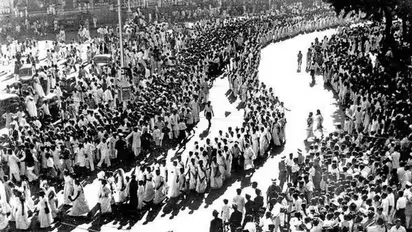India@75 moments: The Quit India Movement that united Indian people against British rule

Synopsis
During the launch of the movement, the Father of the Nation delivered a speech and gave a call for ‘do or die’ at the Bombay session of the Congress at the Gowalia Tank Maidan.
Quit India Movement or ‘Bharat Chodo Andolan’, also known as August Kranti Movement, was a war cry given by Mahatma Gandhi on 8 August, 1942 at the Bombay session of the All India Congress Committee (AICC), for an end to the British rule in India. This movement was a mass civil disobedience that took place across the country.
Britain was in the midst of World War II and pressure was mounting on them to decide India’s future status with the Japanese approaching India’s border. Leaders of the Congress were waiting to grab this opportunity to put pressure on the British government to agree to their demand.
The Cripps mission, under the leadership of Sir Stafford Cripps, who was a member of the War Cabinet, failed in April 1942, however, within less than four months, the third great mass struggle of the Indian people for freedom started. Mahatma Gandhi during World War II passed a resolution of the Quit India Movement.
During the launch of the movement, the Father of the Nation delivered a speech and gave a call for ‘do or die’ at the Bombay session of the Congress at the Gowalia Tank Maidan. He demanded the British to leave India immediately or face dire consequences. As a part of this movement, a call for mass agitation was followed by violence that took over the country after which Indian National Congress leaders were arrested.
Gandhi, in his speech said, “There is a mantra, a short one that I give you. You imprint it in your heart and let every breath of yours give an expression to it. The mantra is do or die. We shall either be free or die in the attempt”. “Quit India” and “Do or Die” became the battle cries of the Indian people during the Quit India movement.
Following the arrest of Congress leaders, there were hartals and processions in every part of the country. The government let loose a reign of terror and there were firings, lathi charges, and arrests throughout the country. People in their anger also took to violent activities. The people attacked government property, damaged railway lines, and disrupted posts and telegraphs. There were clashes with the police at many places.
The government imposed restrictions on the publication of news about the movement. Many newspapers decided to shut down rather than submit to the restrictions.
The main reason for the Quit India Movement to begin was because the Britishers were planning to drag the country into World War II without consent to fight on behalf of the United Kingdom (UK). During that time, more than 87,000 Indian soldiers were martyred in World War II including people from Pakistan, Nepal, and Bangladesh.
By the end of 1942, about 60,000 people had been jailed and hundreds were killed. Among the killed were many young children and old women.
There is no doubt that the “Quit India Movement”, united the Indian people against British rule. Although most of the demonstrations were suppressed by 1944. But after Gandhiji’s release in 1944 from the prison, he continued his protest and went on a 21-day fast. By the end of World War II, Britain's position in the world had changed dramatically and the demand for independence could no longer be ignored.
Every year on 8 August, the anniversary of Quit India Movement is marked and observed by paying tribute to freedom fighters who without a doubt laid their lives for the country and its people.